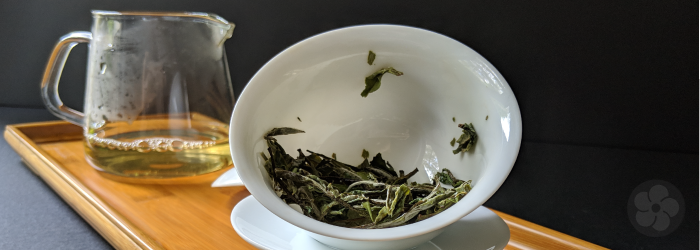6 Brewing Steps to Test Tea Quality

During our annual sourcing trips to China and Taiwan, we are presented with a variety of teas at each farm we visit. Some farms grow many different varieties of the tea plant, but every farm produces many lots of tea throughout the harvest season, with differences based on the exact day of harvest and minor adjustments in crafting techniques. Our job is to discern the most subtle of flavor differences and curate our selection to include only the very best. To ensure we get an accurate tasting, we use our own version of the gong fu cha brewing method. Here are the steps we take to gauge the quality of every tea we get the opportunity to taste.
1. Observe at every stage.
From the dry leaves to the brewed liquor, simple observations can reveal basic indicators of quality. Are the leaves chopped or whole? Chopped leaves typically release flavor, as well as bitter tannins, more quickly. Do the leaves unfurl quickly while brewing, or do they take a long time to expand? Longer expansion times mean the leaf is fully dehydrated and will store well over the long term. Is the brewed tea clear? A “muddy” brew can indicate impurities or artificial flavors that have been washed from the leaf. And finally, what color are the leaves and the brew? While the ideal answer will vary between tea styles, fresh teas with low oxidation rates like green, white, or lightly oxidized oolong styles should be bright and green in color, not dull, yellow, or brown. (We always bring along our own Jingdezhen gaiwan for a perfectly neutral pure white background.)
2. Warm the gaiwan, add leaves, then smell.
While most tasters will advise smelling the leaves before and after they are brewed, we find this intermediate step crucial for understanding the complex, nuanced aromas of traditional teas. Since hot water activates many of the aromatic compounds in natural teas, dry leaves rarely give an accurate representation of a tea’s flavor. And while taking a whiff after the brew can also be telling, this aroma is heavily impacted by brewing style: use water that is too hot, for instance, and the leaves will smell like overcooked vegetables, no matter what nuances may have existed before.
For the most accurate impression of aroma, we like to warm the brewing vessel first with warm water, before we add the tea leaves. Once the bowl of our gaiwan is heated through, we pour off the water. Then, while the porcelain is still steaming, we add the dry leaves to the bowl. As the steam rises through the dry leaves, it gently releases the aromatic compounds from the tea and carries it up to our nose with every nuance intact.
3. Brew with sippable water temperatures.
Many of the tea farmers and craftsmen we work with prefer their tea brewed strong, with boiling water. However, we find it easier to pick up subtle differences in similar lots when the tea is brewed more gently. By lowering our water temperature, we avoid “overcooking” the leaves, and prevent the release of drying tannins and bitter flavor compounds. To gauge the perfect steeping time no matter what the tea, we watch for the leaves to unfurl, decanting when they are halfway open or beginning to display a brighter color as they re-hydrate.
4. Brew multiple infusions.
One of our most dependable tests of quality is observing how the flavor changes over the course of multiple infusions. Flavor that disappears entirely after the first infusion is either artificially added or a sign of fast, heavily fertilized growth. On the other hand, flavor that gets better over the course of two or three infusions is a sign of healthy tea bushes given time to develop complex flavor compounds deep within the leaf over a season of slow growth.
Find five tips for brewing multiple infusions at home >>
5. Try over-brewing.
Once we have brewed the tea gently to make sure we’re picking up every nuance, it’s time to push it to the limits. For us, the best tea is one we can throw in a thermos with boiling water and sip all day long, so we always want to test for a forgiving brew. While most teas will release bitterness and tannins when stewed for ten minutes in boiling water, the highest quality of any style should retain natural sweetness in the finish and remain drinkable no matter what the brewing method.
6. Taste once the tea has cooled.
Since heat distracts the palate, it is important for us to let the brew cool before completing our tasting process. After brewing and tasting multiple infusions, we rest our palates while the remaining tea cools, and then taste again. A lower temperature can reveal unexpected flavor notes that might not have been obvious when the tea was hot, which may be pleasant nuances in a high quality example, or unpleasant bitter surprises in a low quality tea. Again, tasting in every context helps ensure that even coming back to a forgotten cup of cold tea doesn’t have to be a disappointing experience.
We typically repeat this brewing process more than once in different conditions to account for changes in water, ambient temperature, and human error. On occasion, an underwhelming tea has shown true brilliance when brewed under in a different environment. But no matter how many times we taste, we always return to these six steps to understand the quality of any tea.
How do you choose your favorite teas? Let us know in the comments below!
Sign up for our newsletter to get blog updates in your inbox!







Comments on this post (1)
A very illuminating overview of tea quality evaluation at the source. Also generally helpful for anyone buying teas. Well written, too – thank-you !
— Peter Spruce